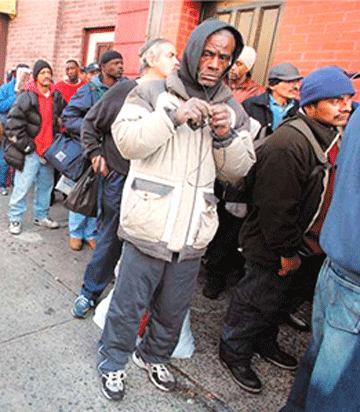Poverty has continued to rise in Connecticut during Connecticut’s slow economic recovery, according to new Census data from the American Community Survey. In 2011, 10.9% of Connecticut residents (377,856) had incomes under the Federal Poverty Level, up from 10.1% in 2010. Poverty increased more quickly among children. Among Connecticut children under age 18, 14.9% (118,809 children) lived in families with incomes under the Federal Poverty Level in 2011, a startling increase from 12.8% in 2010. This child poverty increase was the 5th highest in the nation. (For a two-parent household with two children, the poverty level was $22,811 in 2011.)
Connecticut Voices for Children, a research-based think tank that analyzed the Census data, stated that poverty trends reflect the continued impact of the economic recession, which began in the state in March 2008. Connecticut already experienced the largest increase in poverty of any state between 2007 and 2008, growing from 7.9% to 9.3%. There was a statistically significant increase in poverty among all Connecticut residents over the decade, rising from 7.3% in 2001 to 10.9% in 2011. Poverty also grew significantly among children in the state over the last decade, from 10.2% in 2001 to 14.9% in 2011.
In response to the findings, Connecticut Voices called upon state policymakers to raise the minimum wage, encourage participation in the state and federal Earned Income Tax Credit (EITC), and avoid state budget cuts that could undermine support for low-income families.
“We need to redouble our efforts to reverse these damaging trends by raising the floor for low- wage jobs through a minimum wage increase and avoiding state budget cuts that could plunge more children and families into poverty,” said Jamey Bell, Executive Director at Connecticut Voices for Children. “Children are our economic future, and we can’t afford to leave more and more of them in poverty.”
Connecticut Voices pointed to Connecticut’s new state Earned Income Tax Credit (EITC) as a measure that could pull many working families out of poverty. Connecticut residents have just begun to receive the benefits of the state EITC this year. The federal version of the EITC, started by President Nixon and greatly expanded by President Reagan, lifts more children out of poverty than any other federal program, according to a report by the Center on Budget and Policy Priorities. The state version of this credit for low-income workers is intended to help offset Connecticut’s greater cost of living and to reward work.
“The new state EITC will put more money directly into the hands of low-income people working hard to reach the middle class,” said Wade Gibson, Senior Policy Fellow at Connecticut Voices for Children. “We need to make sure that eligible families know about both the state and federal tax credits.”
Estimates of poverty rates varied significantly across Connecticut’s cities: Bridgeport (25.7%), Danbury (13.9%), Hartford (36.0%), New Britain (25.5%), New Haven (30.1%), Norwalk (8.0%), Stamford (11.1%), and Waterbury (21.5%). The percentage of children under 18 in poverty in Connecticut cities was also reported for Bridgeport (39.9%), Danbury (17.9 %), Hartford (47.9%), New Britain (35.7%), New Haven (41.4%), Norwalk (7.7%), Stamford (17.5%), and Waterbury (34.5%). Poverty estimates are only available at this time for cities with populations over 65,000. There were no statistically significant changes in poverty or median household income estimates for Connecticut cities between 2010 and 2011.

The American Community Survey also provided poverty estimates for Connecticut’s counties and Congressional districts. There were significant increases in the poverty rate among all residents and among children in New Haven County and Tolland County. There was also a significant increase in poverty in the 1st Congressional district (represented by Rep. Larson). (Congressional district data are based on 2011 boundaries, prior to redistricting in 2012. See attached fact sheet for details on county and Congressional district estimates.)
Statewide, the poverty rates for Hispanics (27.3%) and African Americans (22.9%) were dramatically higher than the rate for White, non-Hispanic residents (6.2%).
With the establishment of the Child Poverty Council by state legislation in 2004, Connecticut became the first state in the nation to set a goal of reducing child poverty — by half by 2014. In 2003 (the baseline year for the Council), 10.8% of Connecticut’s children in families (“related children”) had incomes below the poverty line. The state set a goal of reducing the poverty rate to only 5% of children in 2014. Connecticut’s poverty rate for children in families (14.8% in 2011) has significantly worsened over the last decade (the 2001 rate was 9.7%). To meet the goal of reducing child poverty by half, Connecticut must reverse course dramatically, according to Connecticut Voices.
Nationwide, the American Community Survey estimated that 15.9% of all Americans (48.5 million) lived in poverty in 2011, a statistically significant increase from 15.3% in 2010. Among children under 18, 22.5% (16.4 million) were under the poverty line in 2011, up from 21.6% in 2010. Median household income also declined nationally, from $51,144 in 2010 to $50,042 in 2011.
“We’re hopeful that recent state actions like the state Earned Income Tax Credit for low-income workers and efforts to generate jobs will begin to reduce poverty, and we’re hoping that the Governor and legislature will seek to do more in the coming year in light of this increase,” said Jim Horan, Executive Director of the Connecticut Association for Human Services.
Median household income in Connecticut was $65,753 in 2011. This was a decline from the income level prior to the recession in 2007, when the median household income was $71,429. However, the 2011 income estimate was not statistically different from the 2010 estimate.
Uninsured
For the fourth year, the U.S. Census Bureau released state-, city-, county- and Congressional district-level estimates for health insurance coverage in Connecticut from the American Community Survey. In Connecticut, an estimated 8.8% (308,945) of all people in Connecticut were without health insurance at the time of the survey. This was not significantly different from the 2008 or 2010 rates. An estimated 2.9% of children under 18 (23,377) were uninsured at the time of the 2011 survey, a significant decrease from the 4.6% rate in 2008, though not significantly changed from the 2010 rate. Estimates for Connecticut city residents who were uninsured at the time they were surveyed for the American Community Survey in 2011 ranged from 10.5% in Waterbury to 23.3% in Bridgeport. There were statistically significant increases in the uninsured rates for all residents and for uninsured children in Bridgeport. There were also declines in the uninsured rates for Stamford residents and for Danbury children. These changes warrant further investigation, according to Connecticut Voices. There were no statistically significant changes in county or Congressional district uninsured rates between 2010 and 2011.
Connecticut Voices pointed to the recent stability in uninsured rates in the face of growing poverty as evidence of the success of early state and federal health reforms, particularly expanded eligibility for parents and pregnant women in the HUSKY health insurance program, extension of Medicaid eligibility for more low-income adults without children, and improved access for young adults up to age 26 to their parents’ health plans.
“State and federal health reforms are working to hold down the numbers of uninsured children in Connecticut during, as parents struggle through this difficult economy to keep their jobs and private health insurance coverage” said Sharon Langer, Senior Policy Fellow at Connecticut Voices. “We need to preserve the policies that are working to support these families.”
Statewide, the uninsured rate for Hispanics (20.4%) and African Americans (12.1%) was substantially higher than the rate for White, non-Hispanic residents (5.9%).
“It’s still early, but the numbers in these historically underserved communities appear to be moving in the right direction, when compared to last year’s numbers of 21.7 percent and 13.8 percent. Access to quality, affordable health care for everyone regardless of income, ethnicity and race should be the goal in Connecticut,” said Frances G. Padilla, president of the Universal Health Care Foundation of Connecticut.
In 2011, 15.1 % (46.4 million) of Americans were uninsured at the time they were surveyed, according to the American Community Survey, a significant drop from 15.5% in 2010. Among children in the U.S., an estimated 7.5% (5.5 million) were uninsured, down from 8.0% in 2010.
Connecticut Voices for Children is a research-based think tank that works to advance policies that benefit the state’s children, youth and families (ctvoices.org).
This news release and fact sheet, along with links to additional national, state, and local data on demographic, social, and housing indicators from the American Community Survey are available on the CT Voices website at www.ctvoices.org/node/2887.
For the fourth year, the US Census Bureau has included a question in its annual American Community Survey (ACS) on health insurance coverage. The question asks whether the person is currently covered by any type of insurance. The results are not directly comparable to data from the Current Population Survey (CPS), released last week, which asked whether respondents were uninsured for the entire previous year. The sample size for the ACS is much larger than the CPS, so 2011 estimates of insurance status are currently available through the ACS for cities and counties with population greater than 65,000. CPS estimates of the uninsured are available only at the national and state levels.

